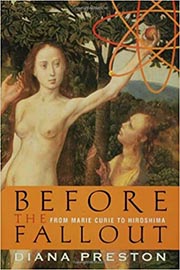Before The Fallout : From Marie Curie to Hiroshima
by Diana Preston
Reviewed August 18, 2005
 The development of the atomic bomb did not begin atop a plateau in New Mexico. It truly began rather innocently nearly fifty years earlier in a laboratory in Paris, when Marie Curie discovered radium. This seemingly unconnected event triggered a race to unlock the secrets of the atom, and in so doing create the atomic bomb. Diane Preston's Before the Fallout, takes us along this journey of discovery to understand the forces of the atom. Although the story of the development of the atomic bomb has been told by numerous authors, Before the Fallout is one of the truly enjoyable accounts of that saga.
The development of the atomic bomb did not begin atop a plateau in New Mexico. It truly began rather innocently nearly fifty years earlier in a laboratory in Paris, when Marie Curie discovered radium. This seemingly unconnected event triggered a race to unlock the secrets of the atom, and in so doing create the atomic bomb. Diane Preston's Before the Fallout, takes us along this journey of discovery to understand the forces of the atom. Although the story of the development of the atomic bomb has been told by numerous authors, Before the Fallout is one of the truly enjoyable accounts of that saga.
As scientists probed the inner workings of the atom, Albert Einstein's now famous equation, E = mc2, foretold of tremendous energies stored within the heart of the atom. Although some thought that this potential was "moonshine,"(I think you should use another analogy. This one feels like you need to use a footnote to describe why you used it) another female scientist led the discovery of nuclear fission. Lise Mietner, who was forced to flee Nazi Germany, correctly interpreted the results of her former colleagues Otto Hahn and Fritz Strassmann. One of the themes that Preston addresses is the sexism that female scientists faced at that time. In addition to the difficulties Marie Curie faced, Preston also explores the difficulties that Lise Meitner endured. For example Hahn and Strassmann were both awarded the Nobel Prize for their work on nuclear fission, while she was not.
The book also traces the nature of science from an apolitical, open global community, to one of secrecy, driven by the fears of World War II. Readers will be presented familiar faces like J. Robert Oppeneheimer, General Leslie Groves, Richard Feynman, and Niels Bohr, as well as the story of the race to develop the atomic bomb.
In addition to the American bomb project, Preston does take some time to explore the atomic bomb projects in Russia, Japan and Germany. She provides some interesting insights in that fateful and mysterious meeting between Niels Bohr and Werner Heisenberg in Copenhagen in 1942.
Throughout the book, Before the Fallout gives us glimpses into the lives behind the scientific minds who gave birth to the atomic age. One notable example was the fact that Fritz Strassmann helped hide a Jewish musician, Andrea Wolffenstein, from the Nazis. This earned him recognition as a "Righteous Gentile" by Yad Vashem in Israel.
Preston also takes us to Hiroshima before and after the bombing. This gives us a better understanding of the city whose name will forever be a part of history. From the bustling port city to a city that was suffering from the impending defeat of the Japanese in World War II.
The book also poses questions to the reader about various turning points in time. "Whatif" President Roosevelt had lived, would he not have used the bomb? What if Britain had not provided the urging to the United States ? the bomb project, would the bomb had been ready in time?
Overall, this book is a wonderful introduction to the birth of the atomic age. Hopefully, readers will be intrigued to continue deeper into this rich and complex topic.